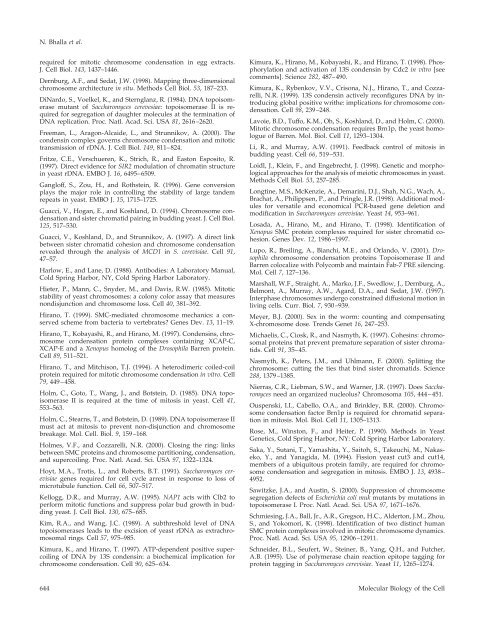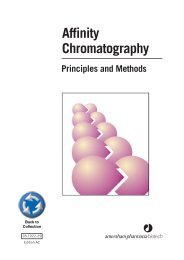Mutation of YCS4, a Budding Yeast Condensin Subunit - Molecular ...
Mutation of YCS4, a Budding Yeast Condensin Subunit - Molecular ...
Mutation of YCS4, a Budding Yeast Condensin Subunit - Molecular ...
Create successful ePaper yourself
Turn your PDF publications into a flip-book with our unique Google optimized e-Paper software.
N. Bhalla et al.required for mitotic chromosome condensation in egg extracts.J. Cell Biol. 143, 1437–1446.Dernburg, A.F., and Sedat, J.W. (1998). Mapping three-dimensionalchromosome architecture in situ. Methods Cell Biol. 53, 187–233.DiNardo, S., Voelkel, K., and Sternglanz, R. (1984). DNA topoisomerasemutant <strong>of</strong> Saccharomyces cerevesiae: topoisomerase II is requiredfor segregation <strong>of</strong> daughter molecules at the termination <strong>of</strong>DNA replication. Proc. Natl. Acad. Sci. USA 81, 2616–2620.Freeman, L., Aragon-Alcaide, L., and Strunnikov, A. (2000). Thecondensin complex governs chromosome condensation and mitotictransmission <strong>of</strong> rDNA. J. Cell Biol. 149, 811–824.Fritze, C.E., Verschueren, K., Strich, R., and Easton Esposito, R.(1997). Direct evidence for SIR2 modulation <strong>of</strong> chromatin structurein yeast rDNA. EMBO J. 16, 6495–6509.Gangl<strong>of</strong>f, S., Zou, H., and Rothstein, R. (1996). Gene conversionplays the major role in controlling the stability <strong>of</strong> large tandemrepeats in yeast. EMBO J. 15, 1715–1725.Guacci, V., Hogan, E., and Koshland, D. (1994). Chromosome condensationand sister chromatid pairing in budding yeast. J. Cell Biol.125, 517–530.Guacci, V., Koshland, D., and Strunnikov, A. (1997). A direct linkbetween sister chromatid cohesion and chromosome condensationrevealed through the analysis <strong>of</strong> MCD1 in S. cerevisiae. Cell 91,47–57.Harlow, E., and Lane, D. (1988). Antibodies: A Laboratory Manual,Cold Spring Harbor, NY, Cold Spring Harbor Laboratory.Hieter, P., Mann, C., Snyder, M., and Davis, R.W. (1985). Mitoticstability <strong>of</strong> yeast chromosomes: a colony color assay that measuresnondisjunction and chromosome loss. Cell 40, 381–392.Hirano, T. (1999). SMC-mediated chromosome mechanics: a conservedscheme from bacteria to vertebrates? Genes Dev. 13, 11–19.Hirano, T., Kobayashi, R., and Hirano, M. (1997). <strong>Condensin</strong>s, chromosomecondensation protein complexes containing XCAP-C,XCAP-E and a Xenopus homolog <strong>of</strong> the Drosophila Barren protein.Cell 89, 511–521.Hirano, T., and Mitchison, T.J. (1994). A heterodimeric coiled-coilprotein required for mitotic chromosome condensation in vitro. Cell79, 449–458.Holm, C., Goto, T., Wang, J., and Botstein, D. (1985). DNA topoisomeraseII is required at the time <strong>of</strong> mitosis in yeast. Cell 41,553–563.Holm, C., Stearns, T., and Botstein, D. (1989). DNA topoisomerase IImust act at mitosis to prevent non-disjunction and chromosomebreakage. Mol. Cell. Biol. 9, 159–168.Holmes, V.F., and Cozzarelli, N.R. (2000). Closing the ring: linksbetween SMC proteins and chromosome partitioning, condensation,and supercoiling. Proc. Natl. Acad. Sci. USA 97, 1322–1324.Hoyt, M.A., Trotis, L., and Roberts, B.T. (1991). Saccharomyces cerevisiaegenes required for cell cycle arrest in response to loss <strong>of</strong>microtubule function. Cell 66, 507–517.Kellogg, D.R., and Murray, A.W. (1995). NAP1 acts with Clb2 toperform mitotic functions and suppress polar bud growth in buddingyeast. J. Cell Biol. 130, 675–685.Kim, R.A., and Wang, J.C. (1989). A subthreshold level <strong>of</strong> DNAtopoisomerases leads to the excision <strong>of</strong> yeast rDNA as extrachromosomalrings. Cell 57, 975–985.Kimura, K., and Hirano, T. (1997). ATP-dependent positive supercoiling<strong>of</strong> DNA by 13S condensin: a biochemical implication forchromosome condensation. Cell 90, 625–634.Kimura, K., Hirano, M., Kobayashi, R., and Hirano, T. (1998). Phosphorylationand activation <strong>of</strong> 13S condensin by Cdc2 in vitro [seecomments]. Science 282, 487–490.Kimura, K., Rybenkov, V.V., Crisona, N.J., Hirano, T., and Cozzarelli,N.R. (1999). 13S condensin actively reconfigures DNA by introducingglobal positive writhe: implications for chromosome condensation.Cell 98, 239–248.Lavoie, B.D., Tuffo, K.M., Oh, S., Koshland, D., and Holm, C. (2000).Mitotic chromosome condensation requires Brn1p, the yeast homologue<strong>of</strong> Barren. Mol. Biol. Cell 11, 1293–1304.Li, R., and Murray, A.W. (1991). Feedback control <strong>of</strong> mitosis inbudding yeast. Cell 66, 519–531.Loidl, J., Klein, F., and Engebrecht, J. (1998). Genetic and morphologicalapproaches for the analysis <strong>of</strong> meiotic chromosomes in yeast.Methods Cell Biol. 53, 257–285.Longtine, M.S., McKenzie, A., Demarini, D.J., Shah, N.G., Wach, A.,Brachat, A., Philippsen, P., and Pringle, J.R. (1998). Additional modulesfor versatile and economical PCR-based gene deletion andmodification in Saccharomyces cerevisiae. <strong>Yeast</strong> 14, 953–961.Losada, A., Hirano, M., and Hirano, T. (1998). Identification <strong>of</strong>Xenopus SMC protein complexes required for sister chromatid cohesion.Genes Dev. 12, 1986–1997.Lupo, R., Breiling, A., Bianchi, M.E., and Orlando, V. (2001). Drosophilachromosome condensation proteins Topoisomerase II andBarren colocalize with Polycomb and maintain Fab-7 PRE silencing.Mol. Cell 7, 127–136.Marshall, W.F., Straight, A., Marko, J.F., Swedlow, J., Dernburg, A.,Belmont, A., Murray, A.W., Agard, D.A., and Sedat, J.W. (1997).Interphase chromosomes undergo constrained diffusional motion inliving cells. Curr. Biol. 7, 930–939.Meyer, B.J. (2000). Sex in the worm: counting and compensatingX-chromosome dose. Trends Genet 16, 247–253.Michaelis, C., Ciosk, R., and Nasmyth, K. (1997). Cohesins: chromosomalproteins that prevent premature separation <strong>of</strong> sister chromatids.Cell 91, 35–45.Nasmyth, K., Peters, J.M., and Uhlmann, F. (2000). Splitting thechromosome: cutting the ties that bind sister chromatids. Science288, 1379–1385.Nierras, C.R., Liebman, S.W., and Warner, J.R. (1997). Does Saccharomycesneed an organized nucleolus? Chromosoma 105, 444–451.Ouspenski, I.I., Cabello, O.A., and Brinkley, B.R. (2000). Chromosomecondensation factor Brn1p is required for chromatid separationin mitosis. Mol. Biol. Cell 11, 1305–1313.Rose, M., Winston, F., and Heiter, P. (1990). Methods in <strong>Yeast</strong>Genetics, Cold Spring Harbor, NY: Cold Spring Harbor Laboratory.Saka, Y., Sutani, T., Yamashita, Y., Saitoh, S., Takeuchi, M., Nakaseko,Y., and Yanagida, M. (1994). Fission yeast cut3 and cut14,members <strong>of</strong> a ubiquitous protein family, are required for chromosomecondensation and segregation in mitosis. EMBO J. 13, 4938–4952.Sawitzke, J.A., and Austin, S. (2000). Suppression <strong>of</strong> chromosomesegregation defects <strong>of</strong> Escherichia coli muk mutants by mutations intopoisomerase I. Proc. Natl. Acad. Sci. USA 97, 1671–1676.Schmiesing, J.A., Ball, Jr., A.R., Gregson, H.C., Alderton, J.M., Zhou,S., and Yokomori, K. (1998). Identification <strong>of</strong> two distinct humanSMC protein complexes involved in mitotic chromosome dynamics.Proc. Natl. Acad. Sci. USA 95, 12906–12911.Schneider, B.L., Seufert, W., Steiner, B., Yang, Q.H., and Futcher,A.B. (1995). Use <strong>of</strong> polymerase chain reaction epitope tagging forprotein tagging in Saccharomyces cerevisiae. <strong>Yeast</strong> 11, 1265–1274.644<strong>Molecular</strong> Biology <strong>of</strong> the Cell
















